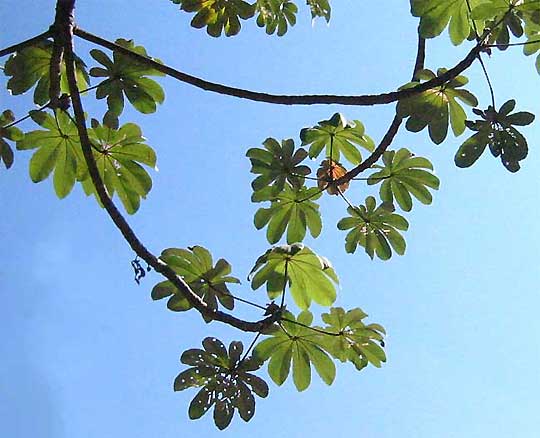Excerpts from Jim Conrad's
Naturalist Newsletter
from the March 17, 2008 Newsletter written in the community of 28 de Junio, in the Central Valley 8 kms west of Pujiltic, elev. ~700m (2300ft), ~N16.331°, ~W92.472°; southeastern Chiapas state, MÉXICO
CECROPIAS
Years ago I lost count of the number of times during the winter I'd bussed south from the US deep into Mexico. During all those trips my first bus-window sighting of a particular tree species always gladdened my heart, for it meant that I'd finally made it back to the tropics.
The tropic-announcing trees were members of the genus CECROPIA, which used to be placed in the Fig Family but new gene-sequencing studies fit it into the Nettle Family. Cecropias just don't grow where during any part of the year it gets very chilly or dry. They need year-round water and heat.
In certain relatively sheltered covess and along streams here we have Cecropias. They're absent from exposed slopes, which are too dry. Probably before the valley floor was converted to sugarcane production Cecropias were common there. You can see a Cecropia's characteristic umbrella-like leaves and gangly, thick, soft-wooded, hollow, wide-spreading branches below:

Two species of Cecropia are listed in Breedlove's Flora of Chiapas, C. peltata and C. obtusifolia. Ours is C. peltata. I think it must be too arid here for obtusifolia, which is common across the mountains on the more humid Gulf side.
Our Cecropia peltata is such a vigorous species that it's become an invasive weed in Hawaii, French Polynesia, West Africa and Malaysia, where it invades disturbed areas, lava flows, and forest gaps. It's even nominated for the Global Invasive Species Database's World's Worst Invaders List.
Once I asked a relatively big-time medicinal herb dealer at the vast Merced Market in Mexico City what he regarded as his most important medicinal plant. Guarumo, he replied in an instant, and Guarumos are Cecropias. Las Plantas Medicinales de México reports that Guarumo is useful against obesity, asthma, liver ailments and diabetes. The trunk's skin contains cecropina, considered to be a powerful heart tonic and diuretic. The plant's greatest use, however, seems to be against "hidropesía," which I don't know how to translate.